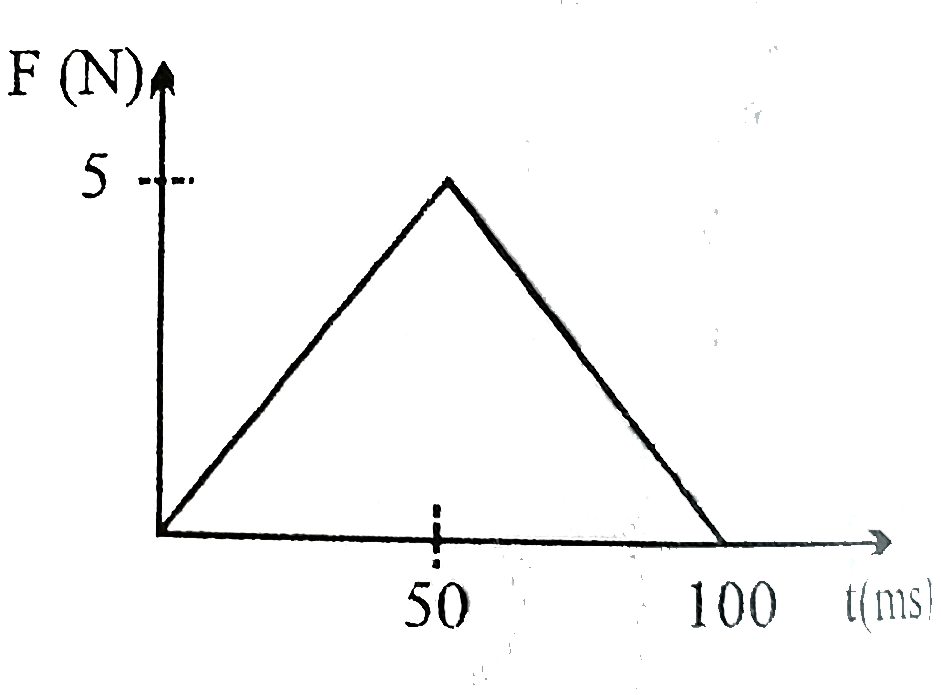Consider two objects of masses 5 kg and 20 kg which are initially at rest. A force 100 N is applied on the two objects for 5 second.
What is the momentum gained by each object after 5 s.
By the principle of homogeneity, a/V2 is of the dimensions of pressure and b is of the dimensions of volume.
[a] = [pressure] [V2]=[ML−1T−2][L6]=[ML5T−2]
[b] =[V]=L3
Topper's Solved these Questions
- APPENDIX 1BOOK - NCERT TAMILCHAPTER - APPENDIX 1EXERCISE - SOLVED EXAMPLE UNIT-4
9 Videos
- APPENDIX 1BOOK - NCERT TAMILCHAPTER - APPENDIX 1EXERCISE - SOLVED EXAMPLE UNIT-5
14 Videos
- APPENDIX 1BOOK - NCERT TAMILCHAPTER - APPENDIX 1EXERCISE - SOLVED EXAMPLE UNIT-2
9 Videos
- GRAVITATIONBOOK - NCERT TAMILCHAPTER - GRAVITATIONEXERCISE - ADDITIONAL EXERCISES
4 Videos
Similar Questions
A force F acts on an object (mass=1 kg) which is initially at rest as shown in the figure. Draw the graph showing the momentum of the object varying during the time for which the force acts.

View SolutionAn object of mass 5 kg is acted upon by a force that varies with position of the object as shown. If the object starts out from rest at a point x=0. What is its speed at x=50 m.

View Solution
Knowledge Check
P and Q are two objects with masses 5 kg and 30 kg respectively. Then
AP has more inertia than QBQ has move inertia than pCP and Q have the same inertiaDneighter P nor Q has any inertiaAn object of mass 0.75 kg is hanging from a string attached to roof.What will be the force applies by string on the object?
A8.45 NB7.35 NC6,.85 ND9.8 NObject #1 moves toward object #2, whose mass is twice that of object #1 and which is initially at rest. After their impact, the object lock together and move with what fraction of object #1's initial kinetic energy?
A118B19C16D13
Two objects slide over a frictionless horizontal surface The first object, mass m1=5 kg, is propelled with a speed u=4.5m/s towards the second object, mass m2=2.5 kg while is intially at rest. After the collision, both objects have velocities which are directed at θ=30∘ on either side of the original line of motion of the first object. What are the final speed of the two object? Is the collision elastic or inelastic?
View SolutionTwo objects slide over a frictionless horizontal surface The first object, mass m1=5 kg, is propelled with a speed u=4.5m/s towards the second object, mass m2=2.5 kg while is intially at rest. After the collision, both objects have velocities which are directed at θ=30∘ on either side of the original line of motion of the first object. What are the final speed of the two object? Is the collision elastic or inelastic?
View SolutionTwo objects are at rest on a level frictionless surface. The objects are not connected. A force F is applied to one of the objects, which then moves with acceleration a. Mark the correct statement(s).
View SolutionAn object of mass 5 kg is acted upon by a force that varies with position of the object as shown. If the object starts out from rest at a point x=0. What is its speed at x=50 m.

View SolutionTwo objects are at rest on a level frictionless surface. The objects are not connected. A force F is applied to one of the objects, which then moves with acceleration a. Mark the correct statement(s).
View Solution
